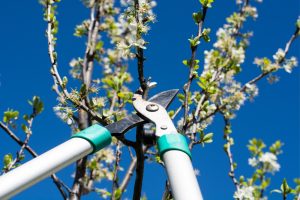As the crisp autumn air settles in and leaves transform into a vibrant tapestry of colour, many Aussie gardeners instinctively pack away their secateurs for the season. But wait! Before you banish your pruning tools to the shed, consider the benefits of giving your plants a pre-winter trim. Prune plants during this dormant period and you’ll be setting them up for a thriving spring and summer. This article will explore the “why” behind winter pruning and equip you with the knowledge to confidently approach this valuable technique.
Should you prune plants before winter?
Not all plants benefit from a winter trim. Here’s a quick breakdown:
- Deciduous plants: These trees and shrubs lose their leaves in autumn. Winter pruning is generally a good idea for them as you can easily see the branch structure without foliage obscuring your view.
- Evergreen plants: These beauties hold onto their leaves year-round. Winter pruning is usually not recommended for them, as it can expose them to harsh winter winds and encourage unwanted new growth during dormancy.
When is the best time to prune plants for winter?
The ideal timing for winter pruning depends on your climate zone and the specific plant types in your garden. Generally, aim to prune in the late dormant season, just before new growth begins to emerge in late winter or early spring.
Early vs. late winter pruning: What’s the difference?
There can be some flexibility within the winter pruning window. Here’s a quick breakdown of the pros and cons of early versus late winter pruning:
- Early winter pruning: This can be beneficial for removing large, diseased branches or shaping overgrown shrubs. However, it’s important to avoid pruning in freezing temperatures to prevent tissue damage.
- Late winter pruning: This is the safer option, particularly for regions with harsh winters. It allows you to assess any winter damage before pruning and coincides with the natural reawakening of the plant.
Which plants benefit most from winter pruning?
Several plant types respond particularly well to a winter prune:
- Fruit trees: Pruning fruit trees in winter helps improve fruit quality and production by allowing for better light penetration and air circulation. Focus on removing dead, diseased, or overcrowded branches.
- Flowering shrubs: Winter pruning encourages bushier growth and promotes more flowers next spring. Prune after the danger of severe frosts has passed but before new buds appear. Examples include forsythia, lilac, and weigela.
- Overgrown perennials: Many perennials benefit from having their dead stems removed before winter. This allows for better air circulation and a tidier garden while encouraging new growth in spring. Examples include rudbeckia, echinacea, and sedum.
How to prune plants for winter: essential techniques
Now that you understand the “why” and “when” of winter pruning, let’s get hands-on! Here’s a step-by-step guide to ensure you prune effectively:
- What tools do you need?
Sharp secateurs, loppers (for thicker branches), and pruning gloves are essential. Consider disinfecting your tools before use to minimise the spread of disease.
- How to identify and remove dead, diseased, or damaged branches
Look for branches that are brittle, discoloured, or have signs of insect infestation. Cut these branches back to a healthy node (a bump where new growth originates).
- Shaping and thinning techniques for winter pruning
For shaping, focus on removing outward-growing branches to maintain a desired form. Thinning involves selectively removing entire branches to improve air circulation and light penetration within the plant.
What are the benefits of winter pruning plants?
Winter pruning offers a range of advantages for your garden:
- Improved plant health: By removing diseased or damaged branches, you reduce the risk of further infection and encourage healthy new growth.
- Enhanced air circulation and light penetration: Pruning opens up the plant canopy, allowing for better airflow and increased sunlight reaching all parts of the plant. This can lead to improved overall health and flower production.
- Encouraging new growth in spring: Winter pruning stimulates the plant to produce new shoots and buds in spring, resulting in a bushier and more vibrant plant.
- Reduced risk of winter damage: Removing heavy branches can help prevent them from breaking during winter storms.
Are there any plants you should avoid pruning in winter?
While winter pruning is beneficial for many plants, there are some exceptions:
- Spring-flowering shrubs: These plants, such as azaleas and rhododendrons, set their flower buds in late summer or fall. Pruning in winter can remove these buds, leading to reduced blooms the following spring. Prune these shrubs after they finish flowering in spring.
- Summer-flowering shrubs: These shrubs, like butterfly bush and hibiscus, typically flower on new growth. Winter pruning can remove potential flowering stems. Wait until late spring or early summer to prune these shrubs.
- Trees susceptible to bleeding: Certain trees, like maples and birches, “bleed” sap heavily when pruned in winter. This can be unsightly and potentially stressful for the tree. Prune these trees in late summer or early fall.
Conclusion
Winter pruning may seem counterintuitive, but it’s a valuable technique for promoting a thriving garden come spring. By understanding which plants benefit from a pre-winter trim and following proper techniques, you can give your garden a head start on the new growing season. Remember, winter pruning is about creating a healthy framework for future growth, not about achieving a perfectly manicured look.
Breathe new life into your garden with winter pruning!
Is your garden looking a bit straggly after a long summer? Do you dream of vibrant blooms and lush growth come spring? Then winter pruning might be the secret weapon you’ve been missing!
At A Bargain Gardener, we’re passionate about helping you achieve a thriving garden. That’s why we offer everything you need to tackle winter pruning with confidence. Here’s how we can help:
Don’t let straggly growth hold your garden back! Get in touch with us today! Let’s work together to transform your winter-weary garden into a thriving spring oasis.





